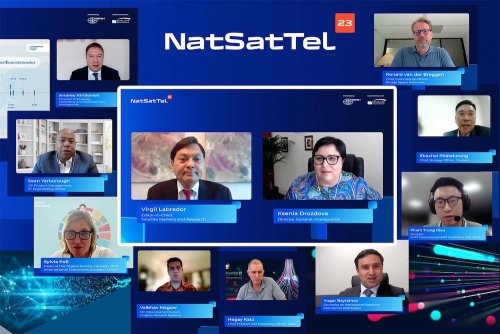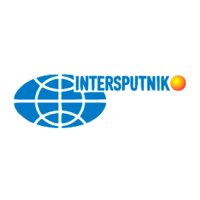Over 150 delegates from 44 countries across various regions, including Africa, Asia-Pacific, Middle East, North and South Americas, Central Asia, and Europe, have attended the online event. NatSatTel-2023 has gained attention from a wide range of private companies, corporations and government organisations. The attendees’ list included global and regional satellite operators, the world’s leading ground equipment vendors and innovative technology developers, consultancy and analytical agencies, international industry organisations and national regulators.
Ksenia Drozdova, Director General of Intersputnik, welcomed the attendees of NatSatTel-2023. In her welcome address Ms Drozdova emphasised the important role that modern satellite technologies play in achieving the United Nations Sustainable Development Goals (SDGs). She also highlighted their importance in improving the quality of life of individuals and bridging the digital divide by connecting communities that are currently not connected. The panel discussions centred around three main topics outlined by conference moderator Virgil Labrador, Editor-in-Chief of Satellite Markets and Research. The evolution of the space segment, innovative technologies and solutions in the ground segment, and the growing significance of youth in driving digitalisation across the global economy and bridging the digital divide.
Jose del Rosario, Senior Research Director at NSR-Analysys Mason, in the opening keynote presentation provided satellite communications market forecast based on key trends including deployment of non-geostationary (NGSO) systems, implementation of direct satellite-to-smartphone communications, and integration of satellite technology into the broader 5G ecosystem. Under the new paradigm, satellite technologies are undergoing a transformation where they are no longer in direct competition with each other or with other technologies. Instead of that, they are increasingly integrated into a unified network that expands into previously untapped markets.
The panel on The Changing Space Segment: Innovations, Key Drivers, and New Players delved into the significant developments taking place in the Fixed Satellite Service market. It specifically addressed the emergence of new players, notably NGSO systems, and the evolving requirements of various vertical market segments.
Andrey Kirillovich, Intersputnik's Director of Strategy, Marketing and Business Development, has pointed out the impact of NGSO systems on the national satellite communications markets and described the challenges they may face as they continue to develop: the incompatibility of regulation and modern technology development, as well as possible conflicts of interest when global satellite systems penetrate national markets. Mr Kirillovich has also pointed out that GEO satellite operators have already solved the majority of the existing issues and recommended the market players, especially at national level, to look more closely at further development of national GEO satellite programmes – the area where Intersputnik has got a wide experience. He also called upon market players to follow Intersputnik’s initiatives and to participate actively in all International Telecommunication Union (ITU) efforts aimed at aligning orbit and frequency regulations more closely with the interests of satcom industry.
Ekachai Phakdurong, Chief Strategy Officer at satellite operator Thaicom, described his vision for the future development of satellite communications: multi-orbit and integration into 5G. Ronald van der Breggen, Chief Commercial Officer of Rivada Space Networks, explained the benefits of a proprietary global low Earth orbit network of satellites connected by laser inter-satellite links.
The panel discussion on Ground Segment: Innovative Technologies and Solutions featured leading vendors of satellite ground equipment – Gilat Satellite Networks, Hughes Network Systems and ST Engineering iDirect. They presented their current solutions for the satellite communications market. Key features important for ground segment systems mentioned by all vendors are as follows: high data rates ground terminal, seamless multi-orbit operations, high-speed communications on the move, Internet of Things via satellite, integration of satellite channels and services into a 5G ecosystem.
Young experts from Intersputnik member states discussed the role and place of youth in digitising the global economy and bridging the digital divide between different regions of the world at the Digital Youth Far Beyond Borders roundtable. Sylvia Poll from the ITU Telecommunication Development Sector and Head of the Digital Society Division of the ITU Telecommunication Development Bureau gave NatSatTel-2023 an overview of the ITU Youth Strategy, the Generation Connect Initiative and projects involving digital youth.
Jean-Benoît Laithier, Principal Advisor at Euroconsult, in his presentation described the main market trends and opportunities for the satellite industry over the next decade. With his closing keynote, Jean-Benoît Laithier harmoniously wrapped up the conference, stating an optimistic future outlook on the development of the industry.
NatSatTel has evolved into a prominent conference that provides a platform for satellite industry experts from around the world to come together and share their perspectives on the current state and future of the industry. The conference offers a valuable opportunity to present new technologies and projects and learn about opportunities to tackle current challenges. Intersputnik follows the principles of open and mutually beneficial international cooperation and is always ready to provide a platform for an equal exchange of views by highly qualified industry experts from all over the world.
 Operations Committee
Operations Committee
